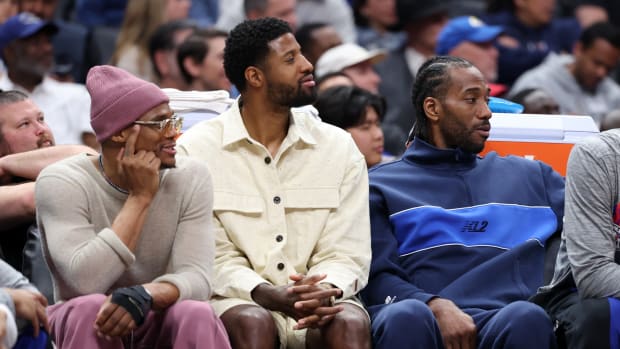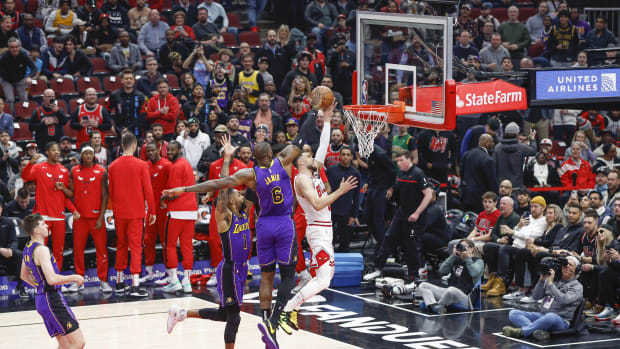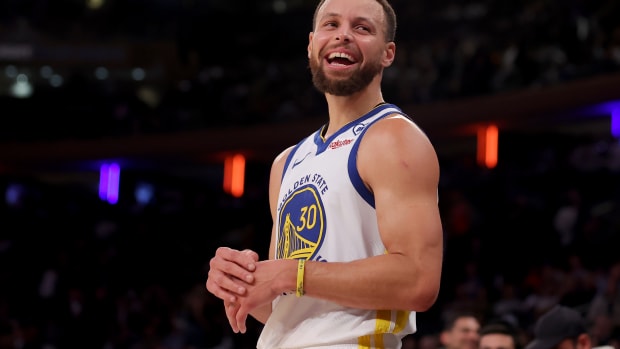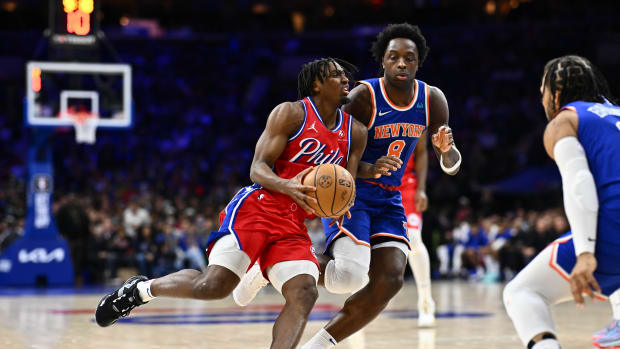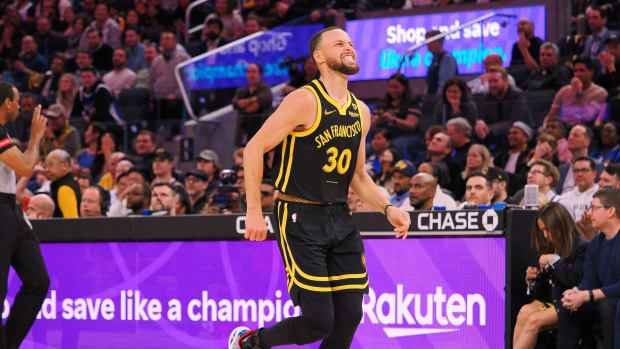Addition by subtraction: Cavaliers' success leaves Kevin Love in limbo
Your teams. Your favorite writers. Wherever you want them. Personalize SI with our new App. Install on iOS or Android.
In the context of these Finals, Kevin Love is his own team’s complication. His very presence necessitates specific matchups against less threatening opponents and strategic choices that minimize the ways in which he can be exploited. Built in to the Cavs' improved Game 3 defense was the fact that they were able to guard differently; Love’s absence, as mandated by the NBA’s concussion protocol, moved LeBron James to the four, Richard Jefferson to the starting frontcourt, and a more straightforward defensive strategy (without need for frantic traps and rotations) to the forefront.
Curry's gone and the Cavs are back... Did the Finals just get interesting?
While that lineup shift didn’t wholly solve the Cavs’ problems, it simplified them to the point that a refocused effort could flip some of the series’ dynamics. Most notably: Cleveland proved that it has the means to sustain a capable defense when operating in smaller lineups, a feat which seemed futile in the opening leg of the series. Love was a part of that, though to blame him for the Cavs’ poor positioning and failed communication through Games 1 and 2 would be foolishly reductive. No player on the floor in this series represents a 63-point swing in performance—that was the chasm between the Warriors’ Game 2 rout and the Cavs’ Game 3 blowout. All that removing Love from the lineup did was afford Cleveland a different, more natural look for the challenge presented them. What they did with that change is far more representative of the shift in the Finals than whether Love plays or sits.
Cleveland will lose every game in this series in which its defensive focus drifts from the details of the assignment at hand. It will lose every game in this series in which both LeBron James and Kyrie Irving aren’t able to read and respond to the first layer of defense, much less the second or third. It will lose every game in this series in which players like Jefferson and J.R. Smith go unactivated on the weak side, snuffed out by Warriors defenders who were never made to help and recover. Love’s play is woven into each of those elements, though not in any way that defines them.
• MORE NBA: LeBron reignites Cavaliers | Cavs need MVP Curry
Regardless, finding the best role for Love upon his return poses something of a challenge. The optics and politics of benching a $20 million player are rarely clean. Love’s frustrations could influence his play if he were made a reserve, while his teammates’ frustrations could influence theirs if he were to be worked over as a starter. There’s no easy answer—particularly when the fact that a specific lineup worked well in Game 3 is no guarantee of its success in Game 4 or beyond. Jefferson, himself, is vulnerable to many of the same defensive issues that bother Love and no more qualified to exploit the Warriors’ switches. It’s generally only a matter of time before Golden State finds comfort and balance enough to pick a lineup change apart. Jefferson is on notice.
The adjustment will likely begin with a corresponding change in the Warriors’ rotation. Whether Andrew Bogut continues to start or not, it seems safe to assume that Golden State will play small far more often for the remainder of the series—perhaps to the point of relegating Bogut, FestusEzeli, MarreeseSpeights, and Anderson Varejao to spot minutes. The lineups operating without a traditional center found real traction in the thick of an ugly Game 3; were it not for some carelessness with the ball, those groups might have completely erased a 20-point first-half deficit and staged an entirely different outcome. Instead, the Warriors’ ill-advised passes in those moments helped to spot the Cavs open looks and layups in transition. Cleaner play would result in a healthier margin, particularly once Golden State gets a handle on the way Cleveland overplayed the passing lanes for deflections and steals in Game 3.
Draymond Green, Kevin Love and the summer that shaped the NBA Finals
It’s somewhat surprising that Warriors coach Steve Kerr didn’t either start the second half in that smaller set or find more occasion to use it. Tristan Thompson may have been the reason why. Baked into the decision to start Jefferson was the worry that Cleveland going small would only encourage Golden State to do the same—that replacing Love with Jefferson would only make it more difficult to penalize the Warriors for playing their most effective all-around lineup. Two factors complicated that theory: 1) Golden State’s aforementioned turnovers hedged against its offensive success, and 2) Thompson single-handedly created seven opportunities for second-chance offense and had a hand in several more. Even the aggressive rebounding efforts of Draymond Green and Harrison Barnes weren’t enough; Thompson is a killer rebounder when his man rotates over to protect the rim, as was necessary on more occasions in Game 3 than at any point in the series previously.
LeBron James vs. Steph Curry
Game 3 of the 2015 NBA Finals
Game 3 of the 2015 NBA Finals
Game 5 of the 2015 NBA Finals
Game 4 of the 2015 NBA Finals
Game 5 of the 2015 NBA Finals
Game 1 of the 2015 NBA Finals
Game 2 of the 2015 NBA Finals
Game 1 of the 2015 NBA Finals
Game 4 of the 2015 NBA Finals
Game 4 of the 2015 NBA Finals
Game 5 of the 2015 NBA Finals
January 18, 2016
Game 3 of the 2015 NBA Finals
Game 2 of the 2015 NBA Finals
Game 2 of the 2015 NBA Finals
Game 4 of the 2015 NBA Finals
Game 1 of the 2015 NBA Finals
Game 2 of the 2015 NBA Finals
Game 4 of the 2015 NBA Finals
Game 2 of the 2015 NBA Finals
February 12, 2014
January 18, 2016
February 15, 2015
December 25, 2015
Game 5 of the 2015 NBA Finals
Game 4 of the 2015 NBA Finals
Game 5 of the 2015 NBA Finals
January 11, 2010
Game 2 of the 2015 NBA Finals
Game 5 of the 2015 NBA Finals
Game 6 of the 2015 NBA Finals
Game 6 of the 2015 NBA Finals
For that, one can credit the flow of Cleveland’s offense, the changing of its pick-and-roll combinations, and the scrapped insistence to attack, over and over, from the same, blunt angles. Cleveland settled in to the point that it made Kerr think twice about leaning on his best lineups, even preferring to trout out the overmatched Varejao for meaningful minutes. The primary value of Golden State’s centers in this series lies in rim protection, rebounding, and sustenance. The latter is the most variable of all; at the point where players like Bogut and Ezeli aren’t able to hold lineups over for minutes at a time, the Warriors would likely be better off running their small-ball lineups on overdrive. It’s exhausting for Green and Barnes to play up a position full-time. When Cleveland executes as it did in Game 3, however, that positioning becomes something close to a necessity.
All of this leaves Love, who would be a mess guarding Green as a small-ball five, in limbo. His most effective matchups in this series are fading out, due in part to how well Cleveland played in the game he missed. What remains are the kinds of messy disadvantages and cross-matches that got the Cavs into trouble in the first place. How Cleveland weathers them is a matter to be settled as a collective—pertinent and specific to Love, no doubt, but rooted in much larger networks of mindful investment. Cleveland’s lightning-rod star is caught somewhere between correlation and causality.































































